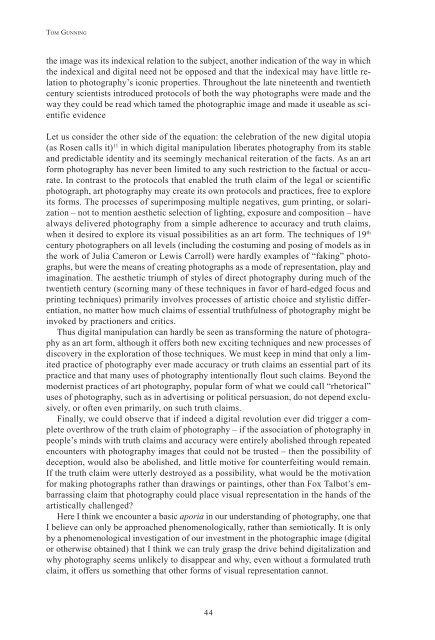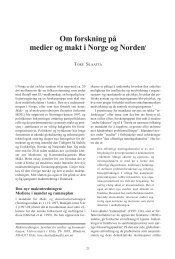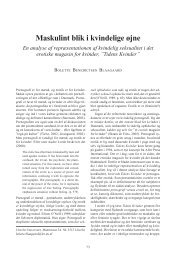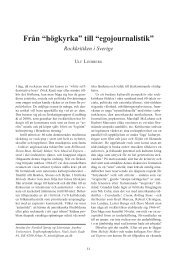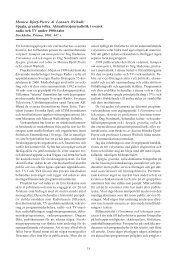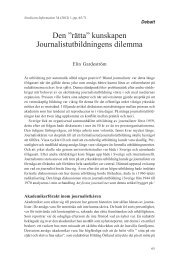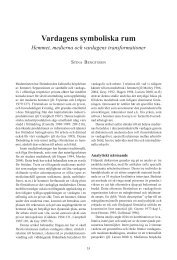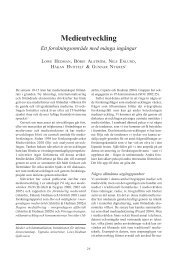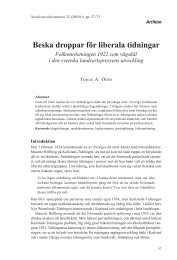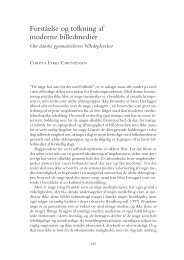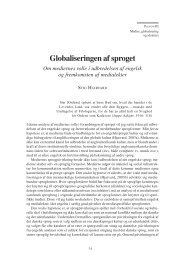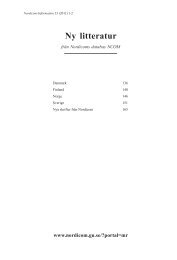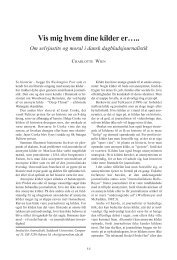What's the Point of an Index? or, Faking Photographs - Nordicom
What's the Point of an Index? or, Faking Photographs - Nordicom
What's the Point of an Index? or, Faking Photographs - Nordicom
Create successful ePaper yourself
Turn your PDF publications into a flip-book with our unique Google optimized e-Paper software.
TOM GUNNING<br />
<strong>the</strong> image was its indexical relation to <strong>the</strong> subject, <strong>an</strong>o<strong>the</strong>r indication <strong>of</strong> <strong>the</strong> way in which<br />
<strong>the</strong> indexical <strong>an</strong>d digital need not be opposed <strong>an</strong>d that <strong>the</strong> indexical may have little relation<br />
to photography’s iconic properties. Throughout <strong>the</strong> late nineteenth <strong>an</strong>d twentieth<br />
century scientists introduced protocols <strong>of</strong> both <strong>the</strong> way photographs were made <strong>an</strong>d <strong>the</strong><br />
way <strong>the</strong>y could be read which tamed <strong>the</strong> photographic image <strong>an</strong>d made it useable as scientific<br />
evidence<br />
Let us consider <strong>the</strong> o<strong>the</strong>r side <strong>of</strong> <strong>the</strong> equation: <strong>the</strong> celebration <strong>of</strong> <strong>the</strong> new digital utopia<br />
(as Rosen calls it) 11 in which digital m<strong>an</strong>ipulation liberates photography from its stable<br />
<strong>an</strong>d predictable identity <strong>an</strong>d its seemingly mech<strong>an</strong>ical reiteration <strong>of</strong> <strong>the</strong> facts. As <strong>an</strong> art<br />
f<strong>or</strong>m photography has never been limited to <strong>an</strong>y such restriction to <strong>the</strong> factual <strong>or</strong> accurate.<br />
In contrast to <strong>the</strong> protocols that enabled <strong>the</strong> truth claim <strong>of</strong> <strong>the</strong> legal <strong>or</strong> scientific<br />
photograph, art photography may create its own protocols <strong>an</strong>d practices, free to expl<strong>or</strong>e<br />
its f<strong>or</strong>ms. The processes <strong>of</strong> superimposing multiple negatives, gum printing, <strong>or</strong> solarization<br />
– not to mention aes<strong>the</strong>tic selection <strong>of</strong> lighting, exposure <strong>an</strong>d composition – have<br />
always delivered photography from a simple adherence to accuracy <strong>an</strong>d truth claims,<br />
when it desired to expl<strong>or</strong>e its visual possibilities as <strong>an</strong> art f<strong>or</strong>m. The techniques <strong>of</strong> 19 th<br />
century photographers on all levels (including <strong>the</strong> costuming <strong>an</strong>d posing <strong>of</strong> models as in<br />
<strong>the</strong> w<strong>or</strong>k <strong>of</strong> Julia Cameron <strong>or</strong> Lewis Carroll) were hardly examples <strong>of</strong> “faking” photographs,<br />
but were <strong>the</strong> me<strong>an</strong>s <strong>of</strong> creating photographs as a mode <strong>of</strong> representation, play <strong>an</strong>d<br />
imagination. The aes<strong>the</strong>tic triumph <strong>of</strong> styles <strong>of</strong> direct photography during much <strong>of</strong> <strong>the</strong><br />
twentieth century (sc<strong>or</strong>ning m<strong>an</strong>y <strong>of</strong> <strong>the</strong>se techniques in fav<strong>or</strong> <strong>of</strong> hard-edged focus <strong>an</strong>d<br />
printing techniques) primarily involves processes <strong>of</strong> artistic choice <strong>an</strong>d stylistic differentiation,<br />
no matter how much claims <strong>of</strong> essential truthfulness <strong>of</strong> photography might be<br />
invoked by practioners <strong>an</strong>d critics.<br />
Thus digital m<strong>an</strong>ipulation c<strong>an</strong> hardly be seen as tr<strong>an</strong>sf<strong>or</strong>ming <strong>the</strong> nature <strong>of</strong> photography<br />
as <strong>an</strong> art f<strong>or</strong>m, although it <strong>of</strong>fers both new exciting techniques <strong>an</strong>d new processes <strong>of</strong><br />
discovery in <strong>the</strong> expl<strong>or</strong>ation <strong>of</strong> those techniques. We must keep in mind that only a limited<br />
practice <strong>of</strong> photography ever made accuracy <strong>or</strong> truth claims <strong>an</strong> essential part <strong>of</strong> its<br />
practice <strong>an</strong>d that m<strong>an</strong>y uses <strong>of</strong> photography intentionally flout such claims. Beyond <strong>the</strong><br />
modernist practices <strong>of</strong> art photography, popular f<strong>or</strong>m <strong>of</strong> what we could call “rhet<strong>or</strong>ical”<br />
uses <strong>of</strong> photography, such as in advertising <strong>or</strong> political persuasion, do not depend exclusively,<br />
<strong>or</strong> <strong>of</strong>ten even primarily, on such truth claims.<br />
Finally, we could observe that if indeed a digital revolution ever did trigger a complete<br />
overthrow <strong>of</strong> <strong>the</strong> truth claim <strong>of</strong> photography – if <strong>the</strong> association <strong>of</strong> photography in<br />
people’s minds with truth claims <strong>an</strong>d accuracy were entirely abolished through repeated<br />
encounters with photography images that could not be trusted – <strong>the</strong>n <strong>the</strong> possibility <strong>of</strong><br />
deception, would also be abolished, <strong>an</strong>d little motive f<strong>or</strong> counterfeiting would remain.<br />
If <strong>the</strong> truth claim were utterly destroyed as a possibility, what would be <strong>the</strong> motivation<br />
f<strong>or</strong> making photographs ra<strong>the</strong>r th<strong>an</strong> drawings <strong>or</strong> paintings, o<strong>the</strong>r th<strong>an</strong> Fox Talbot’s embarrassing<br />
claim that photography could place visual representation in <strong>the</strong> h<strong>an</strong>ds <strong>of</strong> <strong>the</strong><br />
artistically challenged?<br />
Here I think we encounter a basic ap<strong>or</strong>ia in our underst<strong>an</strong>ding <strong>of</strong> photography, one that<br />
I believe c<strong>an</strong> only be approached phenomenologically, ra<strong>the</strong>r th<strong>an</strong> semiotically. It is only<br />
by a phenomenological investigation <strong>of</strong> our investment in <strong>the</strong> photographic image (digital<br />
<strong>or</strong> o<strong>the</strong>rwise obtained) that I think we c<strong>an</strong> truly grasp <strong>the</strong> drive behind digitalization <strong>an</strong>d<br />
why photography seems unlikely to disappear <strong>an</strong>d why, even without a f<strong>or</strong>mulated truth<br />
claim, it <strong>of</strong>fers us something that o<strong>the</strong>r f<strong>or</strong>ms <strong>of</strong> visual representation c<strong>an</strong>not.<br />
44


